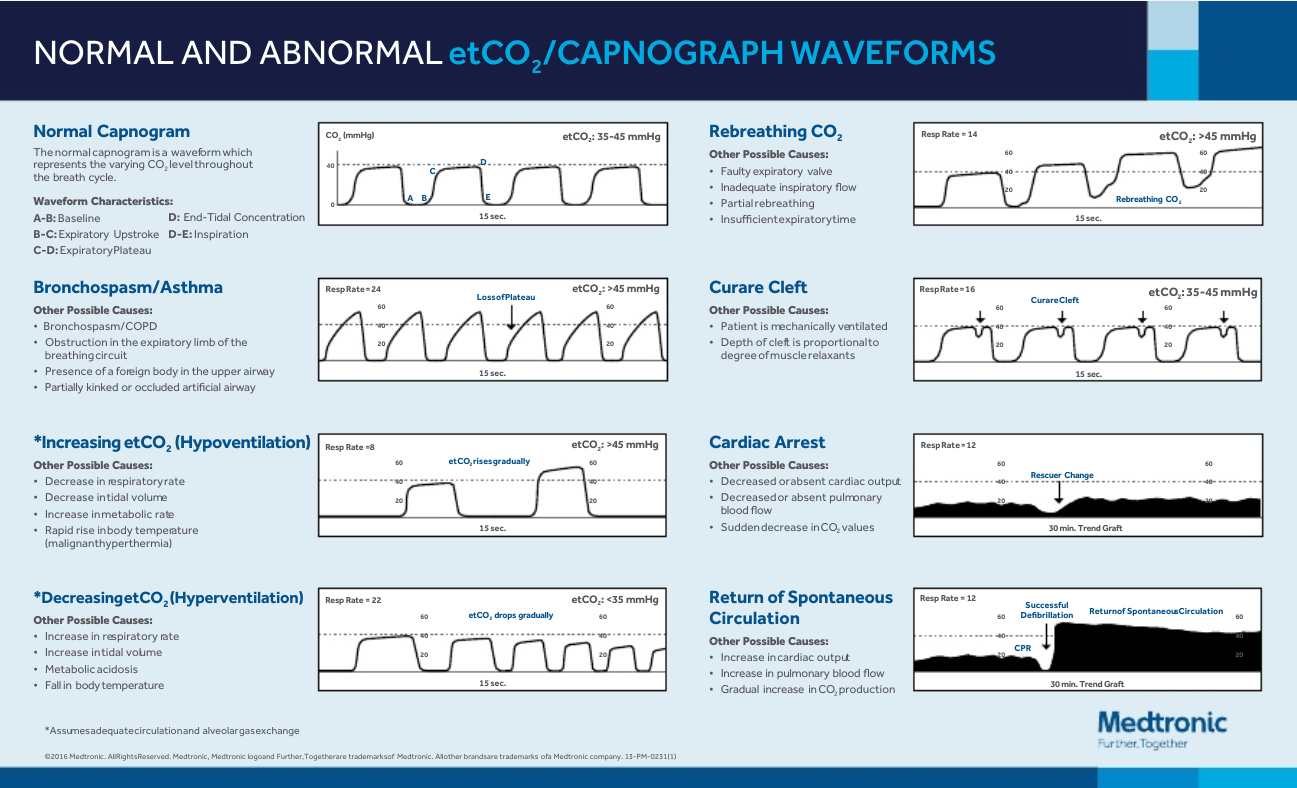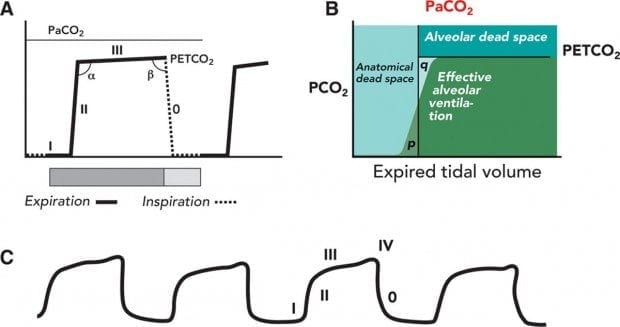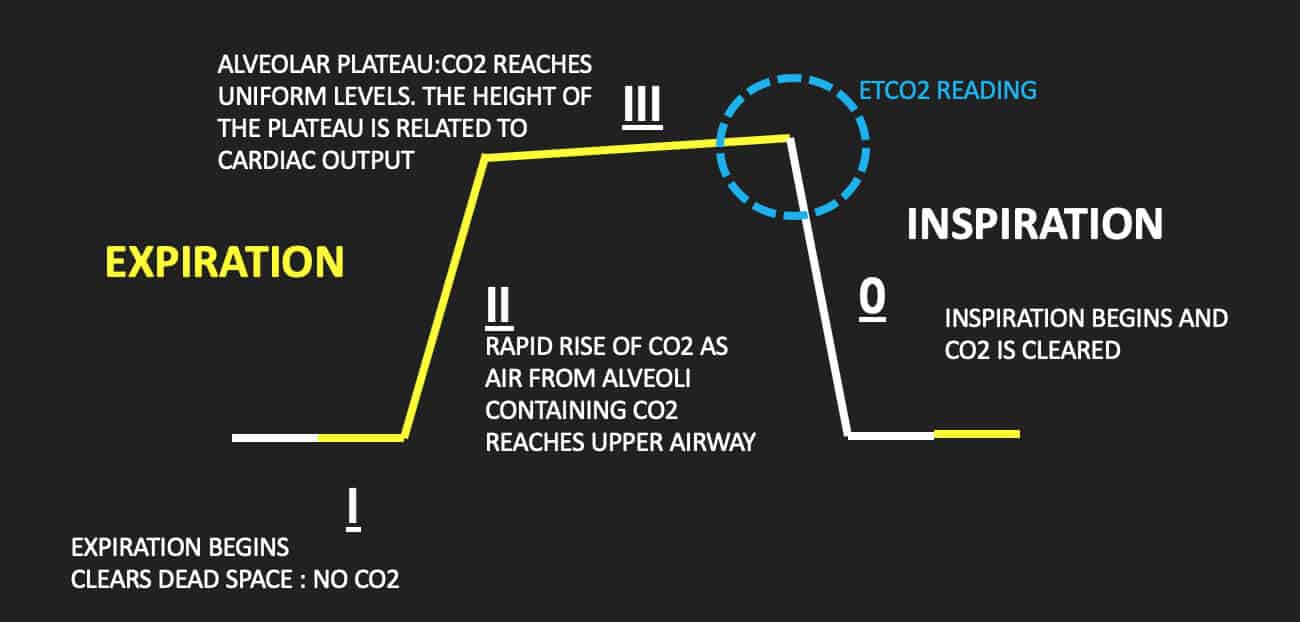end tidal co2 meaning
ETCO2 levels reflect the adequacy with which carbon dioxide CO2 is carried in the blood back to the lungs and exhaled. Types of End Tidal CO 2 Monitors.
End-tidal carbon dioxide ETCO2 is the level of carbon dioxide that is released at the end of an exhaled breath.
. After 20 minutes of CPR death occurs if ETCO2 is consistently below 10 mmHg with 100 sensitivity and specificity 15. ETCO2 is a reliable indicator with a high prognostic value in determining the CPR outcome 11 12. End-tidal capnography or end-tidal CO2 EtCO2 monitoring is a non-invasive technique that measures the partial pressure or maximal concentration of carbon dioxide CO2 at the end of an exhaled breath.
The amount of CO2 at the end of exhalation or end-tidal CO2 ETCO2 is normally 35-45. An end-tidal capnography waveform is a simple graphic measurement of how much CO 2 a person is exhaling. End-tidal carbon dioxide ETco 2 monitoring provides valuable information about CO 2 production and clearance ventilation.
In fact its commonly called the ventilation vital sign. ˈend-ˌtīd-ᵊl Medical Definition of end-tidal. End-tidal carbon dioxide monitoring is a noninvasive method of measuring exhaled carbon dioxide.
Why is ETCO2 important. Definition of Low CO2 hypocapnia Hypocapnia hypocapnea also known as hypocarbia is defined as a deficiency of carbon dioxide in the arterial blood. Can the value of end tidal CO2 prognosticate ROSC in patients coding into emergency department with an out-of-hospital cardiac arrest.
Exhaled carbon dioxide both in terms of its quantity and pattern provides detailed information on the cardiopulmonary system. ETCO2 levels reflect the adequacy with which carbon dioxide CO2 is carried in the blood back to the lungs and exhaled. Savastano S et al.
Endtidal carbon dioxide ETCO2 correlates with systemic blood flow and resuscitation rate during cardiopulmonary resuscitation CPR and may potentially direct chest compression performance. Most medical sources define hypocapnia as less than 35 mm Hg for partial CO2 pressure in the arterial blood. ETCO2 levels reflect the adequacy with which carbon dioxide CO2 is carried in the blood back to the lungs and exhaled.
Sometimes however etCO 2 monitoring is used as a feedback or biofeedback mechanism. Monitoring of end-tidal carbon dioxide EtCO2 is a noninvasive method that measures the partial pressure or maximal concentration of carbon dioxide CO2 at the end of exhaled breath which is expressed as a percentage of CO2. We compared ETCO2 directed chest compressions.
In normal conditions CO2 is 5 to 6 which is equivalent to 35-45 mmHg. This is a major respiratory symptom. End-tidal CO2 EtCO2 monitoring is a noninvasive technique which measures the partial pressure or maximal concentration of carbon dioxide CO2 at the end of an exhaled breath which is expressed as a percentage of CO2 or mmHg.
When the measurement is taken at the end of a breath exhaling it is called end tidal CO 2 ETCO 2. Watch what causes low end tidal co2 Video. End-tidal carbon dioxide and defibrillation success in out-of-hospital cardiac arrest.
Of or relating to the last portion of expired tidal air End-tidal carbon dioxide monitors are already being used and are recommended to indicate the adequacy of cardiopulmonary resuscitation and the likelihood of a successful resuscitation. The normal end-tidal capnography wave form is basically a rounded rectangle. When the spontaneous breathing of the patients started their respirations were supported as the end-tidal carbon dioxide ETC Osub2 value would be 35-40 mmHg.
End-tidal CO 2 monitoring has also been useful for breathing retraining as it provides additional information about the progress of a persons breathing normalization. Also called capnometry or capnography this noninvasive technique provides a breath-by-breath analysis and a continuous recording of ventilatory status. Studies have shown that in patients who had ETCO2 of 10 mmHg or less cardiac arrest was associated with death 13 14.
Carbon dioxide through the respiratory cycle Measuring of End tidal CO2 is considered a standard of care for confirming endotracheal tube placement An important adjunct for assessing a critical patient The Journey of A Molecule Through the Respiratory Cycle. On this page we will look at the following two questions. Whilst capnography assesses ventilation which is the movement of air in and out of the lungs.
End-tidal carbon dioxide ETCO2 is the level of carbon dioxide that is released at the end of an exhaled breath. This technique is often used in patients who are not intubated although it is commonly used in intubated patients receiving mechanical ventilation. The capnogram is a direct monitor of the inhaled and exhaled concentration or partial pressure of CO 2 and an indirect monitor of the CO 2 partial pressure in the arterial blood.
End-tidal carbon dioxide ETCO2 is the level of carbon dioxide that is released at the end of an exhaled breath. This non-invasive monitor can give valuable information about cardiac output perfusion and ventilation. It is the measurement of CO2 at the completion of exhalation and roughly correlates to the CO2 present in arterial blood.
End tidal carbon dioxide concentration MONITORING of end-tidal carbon dioxide is one of the most important means of determining the physiologic well-being of anesthetized patients. End tidal CO 2 EtCO 2 monitoring is the fastest indicator of ventilatory compromise. End-tidal carbon dioxide monitoring ETCO2 has clinical uses far beyond solely determining hypo- or hyperventilation.
CO2 is a byproduct of cellular metabolism which gets transported in the blood to the lungs for elimination. The arterial CO2 value for normal breathing at rest is 40 mm. Monitoring end-tidal CO 2 ET-CO 2 provides instantaneous information about ventilation how effectively CO 2 gas is being exhaledeliminated by the respiratory system perfusion how effectively CO 2 is being transported through the vascular system to the lungs and metabolism how effectively CO 2 is being produced by cellular metabolism.
Pulse oximetry assesses oxygenation which is the amount of oxygen that is bound to red blood cells. The normal values are 5 to 6 CO2 which is equivalent to 35-45 mmHg.
Riding The Wave Of Capnography Understanding Etco2 Vetbloom Blog
The Normal Capnograph Waveform Deranged Physiology

Waveform Capnography In The Intubated Patient Emcrit Project

Normal And Abnormal Capnography Waveforms Infographic Capnoacademy Capnoacademy

Etco2 Valuable Vital Sign To Assess Perfusion The Airway Jedi

Potential Applications Of Capnography In The Prehospital Setting Journal Of Paramedic Practice

End Tidal Co2 Monitoring In The Pre Hospital Environment More Than Just Endotracheal Tube Placement Confirmation Journal Of Paramedic Practice
End Tidal Co2 The Drummer Of The Vital Sign Band Pem4

Basic Capnography Interpretation Nuem Blog

Quantitative Waveform Capnography Acls Medical Training
Emdocs Net Emergency Medicine Educationcapnography In The Ed Emdocs Net Emergency Medicine Education

Waveform Capnography In The Intubated Patient Emcrit Project

Capnography Provides Bigger Physiological Picture To Maximize Patient Care Jems Ems Emergency Medical Services Training Paramedic Emt News
Riding The Wave Of Capnography Understanding Etco2 Vetbloom Blog

Waveform Capnography In The Intubated Patient Emcrit Project

Capnography Waveform Interpretation Litfl Ccc Equipment
5 Medical Conditions Where Capnography Can Affect Bls Care Capnoacademy Capnoacademy


